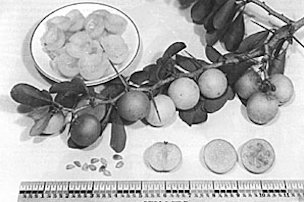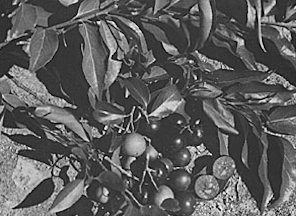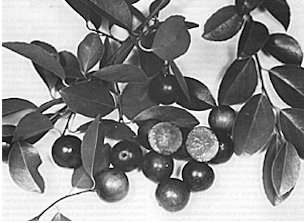From the book
Fruits of Warm Climates
by Julia F. Morton
Kei Apple
Dovyalis caffra Warb.
Aberia caffra Harv. & Sond.
FLACOURTIACEAE
The kei apple, Dovyalis caffra Warb. (syn. Aberia caffra
Harv. & Sond.) is also known as umkokolo in Africa and this is
abbreviated to umkolo in the Philippines. The generic name has been
rendered Doryalis by many writers but botanists now agree that this form was not the original spelling.

Fig. 88: The kei apple tree (Dovyalis caffra) is drought-tolerant, salt-resistant and strikingly fruitful, but the fruit is intensely acid.
Description
The shrub or
small tree, growing to a height of 30 ft (9 m) with a spread of 25 ft
(7.5 m), usually has many sharp spines 1 to 3 in (2.5-7.5 cm) long,
though it is often entirely spineless if not trimmed. The leaves, often
clustered on short spurs, are oblong-obovate, 1 to 3 in (2.5-7.5 cm)
long, glossy and short-petioled. Pale-yellow male and female flowers
are usually borne on separate trees. They are small, petalless, and
clustered in the leaf axils. The aromatic fruit is oblate or nearly
round, 1 to 1 1/2 in (2.5-4 cm) long, with bright-yellow, smooth but
minutely downy, somewhat tough skin, and mealy, apricot-textured,
juicy, highly acid flesh. There are 5 to 15 seeds arranged in double
rings in the center. They are flat, pointed and surrounded by
threadlike fibers. The tree is spectacular when its branches are laden
with these showy fruits.
Origin and
Distribution
The
kei apple is native to the Kei River area of southwest Africa and
abundant in the wild around the eastern Cape, Kaffraria and Natal. It
is cultivated in the Transvaal. In 1838, it was introduced into England
and from there distributed to Egypt, Algeria, southern France and
Italy, the Philippines, northwestern Australia, Jamaica, southern
California and Florida. The United States Department of Agriculture
obtained plants from Reasoner Bros., Oneco, Florida in 1901 (S.P.I.
#6857); seeds from South Africa in 1901 (S.P.I. #7955 & #7956);
seeds from the Cape Town Public Gardens in 1906 (S.P.I. #18667); seeds
from the Middle Egypt Botanic Gardens in 1912 (S.P.I. #34250); and
seeds from Hubert Buckley, St. Petersburg, Florida (S.P.I. #145592) and
the resulting seedlings were being distributed from the Plant
Introduction Garden, Coconut Grove, in 1942 and 1943. A few specimens
were planted in experimental stations in Puerto Rico and St. Croix, and
in private gardens in southern and central Florida, and the plant was
adopted as a coastal, rough hedge in southern California. It has been
grown as a hedge and for its fruit in some parts of Costa Rica. It was
in the past extensively cultivated as a hedge around citrus groves in
Israel, but the fruits were not liked, they accumulated on the ground
and became breeding places for the Mediterranean fruit fly. Therefore,
nearly all the plants were destroyed.
Climate
The kei apple is
subtropical; does poorly at sea-level in the Philippines but thrives at
and above 2,600 ft (800 m). Introductions have failed to survive in
Malaya. In Florida, the plant has been grown in a small way as far
north as Gainesville, enduring brief drops in temperature to 20° F
(-6.67° C) but descents to 16º F (-8.80° C) have been lethal in this
state and in California.
Soil
The kei apple does well
in almost any soil that does not have a high water table. It is
extremely drought-resistant and tolerates saline soil and salt spray
and is accordingly valued as a coastal hedge in the Mediterranean
region and in California.
Propagation
Propagation is
ordinarily by seeds, though layering is successfully done in Australia.
Seeds germinate readily when fresh and seedlings begin to bear in 4 or
5 years. For fruit production, Wilson Popenoe recommended a spacing of
no less than 12 to 15 ft (3.5-4.5 m). Hedge plants can be set 3 to 5 ft
(0.9-1.5 m) apart. According to Popenoe there should be 1 male for
every 20 or 30 females. However, certain female trees have borne
profusely in the absence of male pollinators. A kei apple hedge must be
trimmed twice a year. If neglected and allowed to become leggy, it can
be cut to the ground and given a new start. Weeding should not be a
problem, for the kei apple exhibits allelopathy, that is, its roots
excrete growth inhibitors which prevent the occurrence of other plants
in its vicinity. Investigators in Egypt have demonstrated that the
roots, stem and fruit, but not the leaves and branches, possess
antibiotic properties.
Season
Generally, the plants
bloom in spring and the fruits ripen from August to October. The thorns
make harvesting difficult. The top may have to be thinned out in order
to facilitate fruit-picking.
Food Uses
Most people
consider the fruit too acid for eating out-of-hand even when fully
ripe. It is best cut in half, peeled, seeded, sprinkled with sugar and
allowed to stand for a few hours before serving as dessert or in fruit
salads. The halves can stand only a few minutes of cooking before they
turn into sauce. Simmered briefly in sirup, they make excellent
shortcake. Kei apples are customarily made into jam and jelly, and,
when underripe, pickles.
Food Value
Fresh ripe fruits
contain 83 mg ascorbic acid per 100 g and 3.7% pectin. Scientists in
Egypt have reported 15 amino acids: alanine, 0.41%; arginine, 0.36%;
aspartic acid, 0.96%; glutamic acid, 2.00%; glycine, 0.39%; histidine,
0.10%; isoleucine, 0.25%; leucine, 0.75%; lysine, 0.36%; methionine +
valine, 0.28%; phenylalanine, 0.40%; proline, trace; serine, 0.48%;
threonine, 0.34%.
Related
Species
In the family Flacourtiaceae, there are several species of Flacourtia that have been distributed as fruit producers. None has any great merit, and four shall be treated as minor subjects here.
The louvi, F. inermis Roxb., is called rukam masam, rokam masam, lovi-lovi, lobeh-lobeh, tomi and thornless rukam
in Malaya. The tree is short-trunked, bushy, to 25 or 30 ft (7.6-9 in)
tall, and thornless. The evergreen, alternate leaves, bright-red when
young, are glossy on the upper surface, dull beneath; 3 1/2 to 10 in
(9-25 cm) long and 2 to 5 in (5-12.5 cm) wide. Unlike other species,
the tree has bisexual flowers. They are petalless with green sepals and
many yellow stamens and borne in small clusters along the branches. The
fruit is round but slightly flattened at the apex, 3/4 to 1 in (2-2.5
cm) wide, smooth, bright-red, thin-skinned. The flesh is whitish tinged
with pink, astringent, acid or occasionally sweet. There are 4 to 14
hard, sharp, irregular seeds under 1/4 in (6 mm) wide. The tree is of
unknown origin; cultivated in Ceylon, Malaya and Indonesia. Its
lifespan is said to be about 20 years. It is propagated by seed in
Malaya, by air-layering or budding in Java. Flowering occurs several
times a year. Yield from dooryard trees varies from 81 to 241 lbs
(36.8-109.5 kg) a year. Those given good cultural attention may bear a
total of 374-576 lbs (170-261.8 kg). The fruits are not favored raw but
are seeded and cooked with apples to add color, or are made into pie,
jam, jelly, sirup, chutney and pickles.

Fig. 89: The paniala (Flacourtia jangomas) of southern Asia and the Philippines, has wine-red, plumlike fruits, unfortunately very astringent.
The paniala, F. jangomas Raeusch. (syn. F. cataphracta Roxb.) is also called puneala, puneala plum, jaggam, Chinese plum, Indian plum; in Malaya, kerkup, kerkup besar, kerkup bakoh; in Thailand, ta-khop-thai; in Vietnam, mu cuon, mung quan, bo quan, and prunier malgache.
The shrub or erect, low-branched tree, 20 to 40 ft (6-12 m) high, has
flaking bark and sharp spines on the trunk. The leaves are alternate,
deciduous, pale pink when young, spirally arranged, oval-lanceolate,
long-pointed, toothed, very thin, glossy on both surfaces; 2 to 4 in
(5-10 cm) long, 1/2 to 2 in (1.25-5 cm) wide. Male and female flowers
are on separate trees. They are greenish, heavily fragrant, borne in
small clusters on new branchlets. The fruits are round or slightly
oval, 3/4 to 1 in (2-2.5 cm) long, dark-maroon to nearly black; the
flesh greenish to white or amber, varying from acid to sweet, and
containing 7 to 12 flat, hard, pale-yellow seeds.
The tree is
native to North Bengal, East Bengal and Chittagong in India; commonly
cultivated throughout Southeast Asia, eastern Malaya, and also in the
Philippines. It has been planted in a very limited way in Surinam,
Trinidad, Puerto Rico and southern Florida. The seeds are slow to
germinate, therefore propagation is usually by inarching or budding
onto self-seedlings.
For eating out-of-hand, the fruit is rolled
between the hands to reduce astringency, and is better-liked than that
of other species. It is stewed as dessert, made into juice, sirup, jam,
marmalade and pickles and also used in chutneys. When slightly
underripe, it is used to make jelly. The acid young shoots are eaten in
Indonesia.
Philippine analyses show: moisture, 78.28%; protein,
0.03%; fat, 0.39%; sugar, 4.86%; ash, 0.94%; acidity, 1.16%. The fruit
is fairly rich in pectin; contains 9.9% tannin on a dry-weight basis.
The wood, red or scarlet, is close-grained, hard, brittle, durable and polishes well. It is used for agricultural implements.
The
fruits are eaten to overcome biliousness, nausea and diarrhea. The leaf
decoction is taken to halt diarrhea. Powdered, dried leaves are
employed to relieve bronchitis and coughs. The leaves and bark are
applied on bleeding gums and aching teeth, and the bark infusion is
gargled to alleviate hoarseness. Pulverized roots are poulticed on
sores and skin eruptions and held in the mouth to soothe toothache.

Fig. 90: The ramontchi, or governor's plum (F. ramontchi), closely resembles the paniala. The fruit is sweet but astringent and slightly bitter. The leaves are useful as fodder.
The ramontchi is F. ramontchi L'Her. F. indica has been frequently recorded as a synonym but Indian botanists disagree and treat F. indica Merr. as a distinct species. The common name for the ramontchi in India is governor's plum; in Malaya, it is kerkup kechil or lesser kerkup; in Thailand, ta-khop-pa; in the Philippines, bitongol, bolong, or palutan; in Africa, it is called kokowi, Madagascar plum or Indian plum.
The
tree is bushy and spreading but may reach 50 ft (15 m) and usually has
sharp spines on the trunk and on main branches which tend to arch and
droop at the tips. The evergreen, alternate leaves, red when young, are
obovate to oblong-obovate, 1 to 2 in (2.5-5 cm) long and finely
toothed. Male and female flowers are borne on separate trees. They are
white, about 3/16 in (5 mm) wide, and appear singly or paired in the
leaf axils. The fruit is round, 1/2 to 1 in (1.25-2.5 cm) thick,
smooth, glossy, dark red-purple, with light-brown, acid to sweet,
astringent, slightly bitter, flesh and 6 to 10 small, flat seeds.
The
ramontchi is native to tropical Africa, Madagascar, India, parts of
Malaya and Southeast Asia, and much of Malaysia including the
Philippines. It has been planted in Florida, Puerto Rico, Trinidad,
Guatemala, Honduras and Venezuela and advocated as a source of fruit.
It has never become popular anywhere, but jelly can be made from it by
not squeezing the jelly bag and thus avoiding excessive astringency.
The fruit is usually infested by fruit flies. Analyses made in the
Philippines show: moisture, 66.42%; protein, 0.69%; fat, 1.67%; sugar,
7.68%; ash, 1.09%; acidity, 1.78%.
In Florida, birds scatter the
seeds and volunteers invade natural areas. In Puerto Rico, the tree is
considered useful as a tall barrier hedge or windbreak. Farmers in
India lop the branches for fodder. The wood is used only for fuel.
The
leaves and roots are believed to be effective against snakebite and the
pulverized bark, mixed with sesame oil, is applied on rheumatic parts.
Filipinos use the bark infusion as a gargle. A root infusion is taken
in cases of pneumonia. The leaf juice is given as a febrifuge and
remedy for coughs, dysentery and diarrhea. The dried leaves are
regarded as carminative, expectorant, tonic and astringent.
The rukam, F. rukam Zoll. & Mor., also called rukam manis, rukam gajah and Indian prune in Malaya; khropdong
in Thailand, is a much-branched, crooked tree to 40 or even 65 ft
(12-20 m), sometimes thornless in cultivation but usually heavily armed
with forked, woody spines on the trunk and old branches. The leaves are
evergreen, spiralled, red when young, elliptic-oblong, 3 to 6 in
(7.5-15 cm) long, 1 1/4 to 2 1/2 in (3.2-6.25 cm) wide, coarsely
toothed, slightly shiny. Flowers are in small clusters in the leaf
axils. Male and female are usually on separate trees; occasionally both
occur on the same plant. There are no petals; the male have many
stamens.
The fruits, borne on old branches or on the trunk, are
nearly round, slightly flattened at the apex, 1/2 to 1 in (1.25-2.5 cm)
wide, dark purple-red, smooth, with whitish, juicy, acid flesh. There
are 4 to 7 flat seeds.
The tree is native to India, Southeast
Asia, Malaysia and Oceania; cultivated in southern Malaya and
Indonesia. It is adapted to elevations up to 5,200 ft (1,600 m). Seeds
came to the USDA from Bangkok in 1920 (S.P.I. #51772). A few specimens
have been grown in Florida.
The fruits are eaten raw, especially
after rolling them between the palms to reduce astringency. They are
also cooked, made into pie, jam and chutney. The young shoots are
marketed and eaten raw in Java.
Analyses made in the Philippines
show: calories 82.80 per 100 g; moisture, 76.93%; protein, 1.72%; fat,
1.26%; reducing sugars, 4.32%; fiber, 3.71%; other carbohydrates,
11.29%; ash, 0.771%; acidity, 1.29%.
The heavy, strong wood is made into rice pounders in Java; pestles in the Philippines; and clubs in Samoa.
The
juice of immature fruit is taken to halt diarrhea and dysentery. Leaf
juice is applied on inflamed eyelids, and dried, pulverized leaves are
spread on wounds. The root decoction is given to women after
childbirth. The inner bark is used against filariasis in Samoa.
|
|